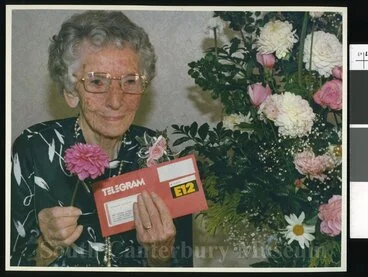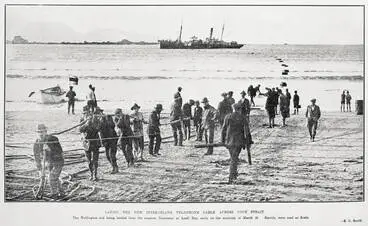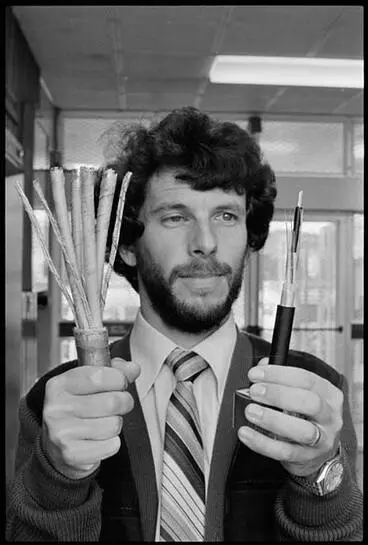Telephones
A DigitalNZ Story by Zokoroa
Telephone styles have evolved from wall-mounted to table top to mobile over the decades with advances in technologies and usage as a social and business tool.
Telephone, Cellphone, Mobile phone, Phone, Telecommmunications, Communication
Boy talking on a telephone
Alexander Turnbull Library
1. Style of phones
Wall telephones
Crank handle on the right & an earpiece/mouthpiece on the left hanging on a hook. Set of twin bells in the middle.
MOTAT
Ear-piece hangs on left. On top of wooden unit are 2 dome-shaped bells. On the front is a mouthpiece & rotary dial.
Wall Telephone
MOTAT
Telephone, Ericsson Tinbox
Awarua Communications Museum
Telephone, Ericsson Magneto 'Skeletal Type'
Awarua Communications Museum
Telephone, New Zealand Post Office Type 101
Awarua Communications Museum
Telephone, Telecom NZPO TYPE 200
Awarua Communications Museum
Telephone
Te Toi Uku, Crown Lynn and Clayworks Museum
Phone Push Button
MOTAT
2. Timeline of key telephony events
The first telegraph opened in New Zealand between the port of Lyttelton & Christchurch on 16 June 1862
DigitalNZ
On 2 Feb 1878, Dunedin electrician Charles Henry organised a 'talking telegraph' trial
His home-made telephone instruments were connected to the telegraph line at Dunedin & Tokomairiro (Milton) Post Office
Hocken Collections - Uare Taoka o Hākena, University of Otago
In 1878 the Govt set up wires between Dunedin and Milton to test the new telephony invention
Telephone poles & copper wire lines often called ‘Lemon trees’ after General Manager of the Telegraph Dpt, Dr Lemon
MOTAT
First call on a private line thought to be made by a Mrs Sheehy in 1878
She took a call from a Roxburgh farm in central Otago. (Source: The Future With Telecom’ report, Telecom 1991)
Kete Horowhenua
Glass insulators manufactured 1890s - 1940s
Used to insulate electrical wires so that the electricity does not leak into the pole & into the earth
Awarua Communications Museum
Kiwi ingenuity: Electrical insulator used 1898 dubbed 'the worse line' in NZ
Six surveyors used glass beer bottle, manuka stick, cons/washers & wire & nearly killed themselves
Awarua Communications Museum
Glass & ceramic preferred for insulators as are poor conductors of electricity
Alexander Turnbull Library
The first telephone office was opened at Port Chalmers in 1879
First link was between Port Chalmers and Portobello so shipping information could be relayed to Dunedin more quickly
National Library of New Zealand
New Zealand Post and Telegraph Department created when Electric Telegraphs Dept merged with Post Office Dept in 1881
The new Dpt later became known as the New Zealand Post Office in 1959
Auckland Libraries
NZ's first manual telephone exchange with battery operated transmitters was in Christchurch in 1881
30 subscribers required to make an exchange viable. Each person rang operator to be connected with the number required.
Auckland Libraries
Female operators were trained and sat in rows connecting calls
The calls were connected by inserting a plug into the socket relating to the number called.
Auckland War Memorial Museum Tāmaki Paenga Hira
Headset and breastplate
Used by switchboard operators at the Awarua Radio Museum
Awarua Communications Museum
Partylines enabled up to 10 people to share the same phone line
South Canterbury Museum
Each phone had a specific ring so they could tell if a call switched by the operator was intended for them
They could also eavesdrop on others' calls, as could the operator if they chose to do so
MOTAT
First subscribers paid annual fee (£17 10s) to rent their phone
Between 1910 and 1950 the number of telephones grew more than tenfold – from around 33,000 to more than 350,000
Auckland Libraries
The telephone became a business and social tool, providing immediate voice contact
Alexander Turnbull Library
Radio amplifier for telephone
Marketed to households in 1920s
Awarua Communications Museum
Sending music, songs and nursery rhymes also became popular (Source: Te Ara)
Alexander Turnbull Library
Public payphone telephone boxes, 1910
The first public telephones were available in the main centres & were coin-operated costing 2d in the slot
MOTAT
Calculagraph used for timing toll calls
Invented in 1888 by clockmaker Henry Abbot & first used in telephony in 1894. NZ telephone exchanges used 90 years.
Awarua Communications Museum
Telephone directory first issued in 1909, & Yellow pages in 1959
Christchurch City Libraries
Country Telecommunications Act (1912) enabled rural areas to build their own networks & link into public network
National Library of New Zealand
Raising telephone pole
Using General Post Office truck, Wellington, circa 1920s.
Alexander Turnbull Library
Raising telegraph pole
Shear-legs used when the pole has reached a height too high for a derrick
Museum of New Zealand Te Papa Tongarewa
[Portrait of two Servicemen up a telephone pole]
Auckland War Memorial Museum Tāmaki Paenga Hira
First automatic exchange equipment used in Auckland & Wellington in 1912 to supplement manual exchange
Automatic exchange increased capacity to handling 500 lines at a time
Tauranga City Libraries
The first private automatic branch exchanges (PABX) appeared in 1925
MOTAT
First telephone cable was laid across Cook Strait in 1926 to replace telegraph cable
Toll calls could be made from anywhere in the North & South Islands
Auckland Libraries
International calls between Wellington & Australia in 1930, & Gt Britain in 1931 using Australian beam wireless stations
Toll operators could place overseas calls via Wellington. A call to Britain cost £6.15s & to Australia £1 per minute.
Trove
From 1950s and 1960s, international submarine cables with more advanced technology are laid
COMPAQ (Commonwealth Pacific) linked NZ to Australia & Fiji (1962), Canada (1963) & South-East Asia (SEACOM) in 1967
Upper Hutt City Library
Training of Post and Telegraph Dpt staff at Trentham with model of telephone pole, 1955
Alexander Turnbull Library
The 111 emergency service number introduced in 1958
Alexander Turnbull Library
By 1959, NZ offered a flat fee for unrestricted calling within local exchange area & toll fees for calls to other areas
Auckland War Memorial Museum Tāmaki Paenga Hira
Coaxial cable was laid from Auckland to Hamilton and from Wellington to Palmerston North in 1960
Tauranga City Libraries
In 1960s, first worldwide satellite links. NZ joined INTELSAT, which was largely American funded, in 1965
By 1966, NZ toll operators were able to dial subscribers direct in Australia and Fiji. without going via Wellington
Manatū Taonga, the Ministry for Culture and Heritage
NZ Post Office opened its first earth-based satellite station at Warkworth in July 1971
Auckland Libraries
3-way conference calls via SPC (Stored Programme Controlled) exchanges from 1980
Calls could also be put on hold, and call diversion used
MOTAT
Fibre-optic cable introduced 1982 & replaced co-axial cable from 1983
Fibre-optic cable had much greater capacity to carry video, data and voice signals
Manatū Taonga, the Ministry for Culture and Heritage
Mobile phones were first available in the 1980s
Manatū Taonga, the Ministry for Culture and Heritage
Nicknamed ‘the brick' due to large size
At its launch in 1984, the Motorola DynaTAC sold for US$4,000
Awarua Communications Museum
Cellular telephone
Te Awamutu Museum
"Look No Cords" - Early Cellphone
Palmerston North City Library
Mobile phones work on cellular networks
Archives New Zealand Te Rua Mahara o te Kāwanatanga
New Zealand Post split into 3 state-owned enterprises on 1 April 1987
- Telecom, Post Bank & New Zealand Post.
Manatū Taonga, the Ministry for Culture and Heritage
Govt sold Telecom to Ameritech, Bell Atlantic, Fay Richwhite Holdings & Freightways Holdings in 1990
Sale conditions: retention of free local calling, nationwide rentals & price increases tied to Cost Price Index
Manatū Taonga, the Ministry for Culture and Heritage
Short message service (SMS), or texting, introduced in 1998
Manatū Taonga, the Ministry for Culture and Heritage
By early 2000s, two Telecom competitors were TelstraClear & Vodafone who were followed by 2degrees & other firms
Legislation in 2006 required local loop unbundling (LLU): telephone lines & exchanges open to rival companies
Christchurch City Libraries
Smartphone features increased from early 2000s
You could play games, receive TV, exchange emails, & use GPS navigation, music (MP3), & other apps (applications)
Manatū Taonga, the Ministry for Culture and Heritage
Also take & send photographs & videos
Christchurch City Libraries
Soundchair with music via iPhone
Aotearoa People's Network Kaharoa
Telecom was re-branded as 'Spark New Zealand Limited' in 2014
Radio New Zealand
Cellphone used for emergency alert messages from authorised agencies
Museum of New Zealand Te Papa Tongarewa
Find out more:
A. C. Wilson, 'Telecommunications', Te Ara - the Encyclopedia of New Zealand, http://www.TeAra.govt.nz/en/telecommunications
Awarua Communications Museum: NZPO evolution - Telephone services, http://www.awaruamuseum.co.nz/nzpo-evolution/nzpo-telephone.html
'Early telephone services in New Zealand', URL: https://nzhistory.govt.nz/media/photo/early-telephone-services-new-zealand, (Ministry for Culture and Heritage), updated 4-May-2016
Michelle Horwood, Museum notebook: A history of Whanganui's telephone exchange', Whanganui Chronicle, 8 June 2020: https://www.nzherald.co.nz/whanganui-chronicle/news/museum-notebook-a-history-of-whanganuis-telephone-exchange/4ZXDUFNJZ6TKLPK7QYNXC6Z6VY/
'The Post and Telegraph Department in 1914', URL: https://nzhistory.govt.nz/war/first-world-war-postal-service/1914, (Ministry for Culture and Heritage), updated 3-May-2016
































![[Timaru Manual Telephone Exchange] Image: [Timaru Manual Telephone Exchange]](https://thumbnailer.digitalnz.org/?resize=770x&src=https%3A%2F%2Fs3.amazonaws.com%2Fpastperfectonline%2Fimages%2Fmuseum_58%2F108%2F7136.jpg&resize=368%253E)









![[Portrait of two Servicemen up a telephone pole] Image: [Portrait of two Servicemen up a telephone pole]](https://thumbnailer.digitalnz.org/?resize=770x&src=https%3A%2F%2Fcollection-api.aucklandmuseum.com%2Frecords%2Fimages%2Fmedium%2F515685%2Fc0c06967f4eee46c59dbc032719f461724417ea2.jpg&resize=368%253E)




















